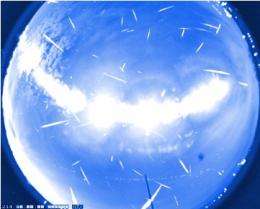Geminids meteor shower to be 'lively' show

Baby, it's cold outside -- but you can still enjoy the best meteor shower of the year. The 2010 Geminid meteor shower promises to be lively, with realistic viewing rates of 50-80 meteors per hour and potential peaks reaching 120 meteors per hour. Anytime between Dec. 12-16 is a valid window for Geminid-watching, but the night of Dec. 13-14 is the anticipated peak.
About the Chats
You have two opportunities to learn more about the Geminids from meteor experts based at NASA's Marshall Space Flight Center. On Monday, Dec. 13 from 3:00 to 4:00 p.m. EST, meteor experts Danielle Moser and Rhiannon Blaauw will answer your questions, then you can stay "up all night" to observe the Geminids with NASA astronomer Bill Cooke. Have the coffee ready, then join them online from 11:00 p.m. to 5:00 a.m. EST as the Geminids peak in the skies over Earth.
Joining the chats is easy. Simply go to this page a few minutes before each of the chat start times list above. The chat module will appear at the bottom of the page. After you log in, wait for the chat module to be activated, then ask your questions. Here's to a spectacular viewing!
Live Camera Viewing of the Geminids
December can be an uncertain month for weather, but clouds and meteor-watching don't mix. To assist in the weather-workaround, NASA and meteor-observing partners are working on a network of live Web cameras that will watch the skies from different locations. Links for the live feeds will be available on this page on the night of Dec. 13-14 -- just in case your local weather is uncooperative or you decide not to brave the chilly December evening.
More About the Geminids
Geminids are pieces of debris from an object called 3200 Phaethon. Long thought to be an asteroid, Phaethon is now classified as an extinct comet. Basically it is the rocky skeleton of a comet that lost its ice after too many close encounters with the sun. Earth runs into a stream of debris from 3200 Phaethon every year in mid-December, causing meteors to fly from the constellation Gemini. When the Geminids first appeared in the late 19th century, shortly before the U.S. Civil War, the shower was weak and attracted little attention. There was no hint that it would ever become a major display.
Provided by JPL/NASA




















